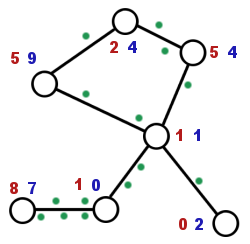Here is an interesting situation for which i need some algorithmic advice. I'm going to make this as simple as possible so as not to pollute the issue with unecessary details. If you want the actual context of the problem, see the bottom of the post. Thanks for your input!
THE SITUATION:
Suppose we have a random number of "towns" sprinkled across an area. Each town is connected to at least one other town via a "road". Like so:

Each town can be a producer and/or consumer of "resources". The goal is to get resources
from producers
to consumers.
Now we have "trucks" which transport the resources across the roads. Each truck can hold a limited amount of "resouces".
Finally, put this whole situation into a turn-based model. Every turn, producers produce some resources and consumers consume some. Each town is a little different in the amount. Some towns produce nothing, only consume. Others vice versa. Some towns do both, so no intercity transportation is necessary in that case.
Every turn, trucks move along the roads a little bit. If they are empty, trucks need to collect resources from producers. If they are full, trucks need to deliver them to consumers. Basically, we are modelling "traffic" here. Here is another illustration showing the towns, the roads, production numbers (blue), consumption (red), and the little green dots are trucks en route.

Sounds simple enough. The problem is that this needs to be
automated. The goal is to "build trucks" and have them "go into service" picking up and making deliveries automatically with no user input. The computer needs to figure out which trucks go where and how often.
So the issue is:
can you think of an algorithm to do this?
What i've considered so far:
- User specified routes. Let the user manually define a route such as A->B. Then just have a truck "subscribe" to a particular route. The problem is that this gets more complex with more towns. It's also not very dynamic in case the needs of towns change.
- 1-to-1 Need-based algorithm. Basically, each town gets matched up with another town that fulfills it's "need" (consumers need producers, producers need consumers). This works, but not very efficiently. Consider: Ideally, a truck should be able to make a chain of stops, not just go back and forth between A and B. It would strategically lay out it's route so that it can pick up and deliver the most resources using the least amount of movement.
- Propagated need-based algorithm. I imagines that each town could "broadcast" it's "need" to each of it's connected neighboring towns. That need, if unmet by the town, would get re-broadcast to all of
it's neigboring towns and so on, like a game of telephone. In this model, trucks only move resources from one town to another neighboring town. No cross-county hauling. This situation makes for a "bucket brigade" model. Caveat: you need enough trucks for at least one per road.
THE CONTEXT:
I'm designing an
abstract strategy game, so it's not about towns and trucks. My game deals with points (towns), transports (trucks) and
several different kinds of resources (4, specifically). Each "point" produces these resources in varying amounts. Other points consume them and make them into things. I want to develop a system that has very little user-input because this situation could easily get overwhelming and tedious if it grows. with 3 or 4 nodes, it's easy, but with 2 dozen, it could be a nightmare.
To make it worse, some of the nodes only need some of the resources some of the time. 3 of the 4 resources are constant and there is always a need for them, but the 4th resources is like "materials" or "work". You move this resource to other points to build things with. So this is only done when there is a need to build something. Once built, the point stops requiring that resource.
Anyway, if you have any ideas on this or if i did not clearly explain what i am looking for, i look forward to hearing from you. Thanks!
 Each town can be a producer and/or consumer of "resources". The goal is to get resources from producers to consumers.
Now we have "trucks" which transport the resources across the roads. Each truck can hold a limited amount of "resouces".
Finally, put this whole situation into a turn-based model. Every turn, producers produce some resources and consumers consume some. Each town is a little different in the amount. Some towns produce nothing, only consume. Others vice versa. Some towns do both, so no intercity transportation is necessary in that case.
Every turn, trucks move along the roads a little bit. If they are empty, trucks need to collect resources from producers. If they are full, trucks need to deliver them to consumers. Basically, we are modelling "traffic" here. Here is another illustration showing the towns, the roads, production numbers (blue), consumption (red), and the little green dots are trucks en route.
Each town can be a producer and/or consumer of "resources". The goal is to get resources from producers to consumers.
Now we have "trucks" which transport the resources across the roads. Each truck can hold a limited amount of "resouces".
Finally, put this whole situation into a turn-based model. Every turn, producers produce some resources and consumers consume some. Each town is a little different in the amount. Some towns produce nothing, only consume. Others vice versa. Some towns do both, so no intercity transportation is necessary in that case.
Every turn, trucks move along the roads a little bit. If they are empty, trucks need to collect resources from producers. If they are full, trucks need to deliver them to consumers. Basically, we are modelling "traffic" here. Here is another illustration showing the towns, the roads, production numbers (blue), consumption (red), and the little green dots are trucks en route.
 Sounds simple enough. The problem is that this needs to be automated. The goal is to "build trucks" and have them "go into service" picking up and making deliveries automatically with no user input. The computer needs to figure out which trucks go where and how often.
So the issue is: can you think of an algorithm to do this?
What i've considered so far:
- User specified routes. Let the user manually define a route such as A->B. Then just have a truck "subscribe" to a particular route. The problem is that this gets more complex with more towns. It's also not very dynamic in case the needs of towns change.
- 1-to-1 Need-based algorithm. Basically, each town gets matched up with another town that fulfills it's "need" (consumers need producers, producers need consumers). This works, but not very efficiently. Consider: Ideally, a truck should be able to make a chain of stops, not just go back and forth between A and B. It would strategically lay out it's route so that it can pick up and deliver the most resources using the least amount of movement.
- Propagated need-based algorithm. I imagines that each town could "broadcast" it's "need" to each of it's connected neighboring towns. That need, if unmet by the town, would get re-broadcast to all of it's neigboring towns and so on, like a game of telephone. In this model, trucks only move resources from one town to another neighboring town. No cross-county hauling. This situation makes for a "bucket brigade" model. Caveat: you need enough trucks for at least one per road.
THE CONTEXT:
I'm designing an abstract strategy game, so it's not about towns and trucks. My game deals with points (towns), transports (trucks) and several different kinds of resources (4, specifically). Each "point" produces these resources in varying amounts. Other points consume them and make them into things. I want to develop a system that has very little user-input because this situation could easily get overwhelming and tedious if it grows. with 3 or 4 nodes, it's easy, but with 2 dozen, it could be a nightmare.
To make it worse, some of the nodes only need some of the resources some of the time. 3 of the 4 resources are constant and there is always a need for them, but the 4th resources is like "materials" or "work". You move this resource to other points to build things with. So this is only done when there is a need to build something. Once built, the point stops requiring that resource.
Anyway, if you have any ideas on this or if i did not clearly explain what i am looking for, i look forward to hearing from you. Thanks!
Sounds simple enough. The problem is that this needs to be automated. The goal is to "build trucks" and have them "go into service" picking up and making deliveries automatically with no user input. The computer needs to figure out which trucks go where and how often.
So the issue is: can you think of an algorithm to do this?
What i've considered so far:
- User specified routes. Let the user manually define a route such as A->B. Then just have a truck "subscribe" to a particular route. The problem is that this gets more complex with more towns. It's also not very dynamic in case the needs of towns change.
- 1-to-1 Need-based algorithm. Basically, each town gets matched up with another town that fulfills it's "need" (consumers need producers, producers need consumers). This works, but not very efficiently. Consider: Ideally, a truck should be able to make a chain of stops, not just go back and forth between A and B. It would strategically lay out it's route so that it can pick up and deliver the most resources using the least amount of movement.
- Propagated need-based algorithm. I imagines that each town could "broadcast" it's "need" to each of it's connected neighboring towns. That need, if unmet by the town, would get re-broadcast to all of it's neigboring towns and so on, like a game of telephone. In this model, trucks only move resources from one town to another neighboring town. No cross-county hauling. This situation makes for a "bucket brigade" model. Caveat: you need enough trucks for at least one per road.
THE CONTEXT:
I'm designing an abstract strategy game, so it's not about towns and trucks. My game deals with points (towns), transports (trucks) and several different kinds of resources (4, specifically). Each "point" produces these resources in varying amounts. Other points consume them and make them into things. I want to develop a system that has very little user-input because this situation could easily get overwhelming and tedious if it grows. with 3 or 4 nodes, it's easy, but with 2 dozen, it could be a nightmare.
To make it worse, some of the nodes only need some of the resources some of the time. 3 of the 4 resources are constant and there is always a need for them, but the 4th resources is like "materials" or "work". You move this resource to other points to build things with. So this is only done when there is a need to build something. Once built, the point stops requiring that resource.
Anyway, if you have any ideas on this or if i did not clearly explain what i am looking for, i look forward to hearing from you. Thanks!








